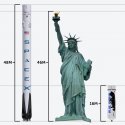Universe Today said:Restoring America’s ability to once again launch US astronauts to (ISS) from US soil on US rockets took another significant step forward when NASA ordered the first the agency’s first rotation mission from the Hawthorne, California based-company . NASA and SpaceX hope that the blastoff with a crew of up to four astronauts will take place by late 2017.
The new Nov. 20 award from NASA’s Commercial Crew Program (CCP) office to launch the Crew Dragon capsule follows up on an earlier commercial crew rotation mission of Houston to launch its to .
Since the retirement of NASA’s Space Shuttle orbiters in 2011, all American and ISS partner astronauts have been forced to hitch a ride on the Russian Soyuz capsule for flights and back, at a current cost of over $70 million per seat.
“The authority to proceed with Dragon’s first operational crew mission is a significant milestone in the Commercial Crew Program and a great source of pride for the entire SpaceX team,” said Gwynne Shotwell, president and chief operating officer of SpaceX, in a statement.
“When Crew Dragon takes NASA astronauts to the space station in 2017, they will be riding in one of the safest, most reliable spacecraft ever flown. We’re honored to be developing this capability for NASA and our country.”
However, actually achieving crew launches by both Boeing and SpaceX before the end of 2017 is completely contingent on whether the companies can satisfactorily meet all of NASA’s human spaceflight certification milestones specifying the vehicles are fully capable and safe for astronauts to fly.
Both companies also plan to conduct unmanned and manned orbital test flights of their crew capsules earlier in 2017, paving the path to orbit prior to initiating the commercial crew rotation missions.
This is the second in a series of four guaranteed orders NASA will make under the Commercial Crew Transportation Capability (CCtCap) contracts.
NASA is making the awards now to both SpaceX and Boeing since it’s expected to take a lead time of about 2 or 3 years to assemble all the hardware required to manufacture the Crew Dragon and Starliner CST-100, respectively, into fully functioning spaceships.
Boeing and SpaceX were worth $6.8 Billion to complete the development and manufacture of the privately developed Starliner CST-100 and Crew Dragon astronaut transporters under the agency’s Commercial Crew Transportation Capability (CCtCap) program and NASA’s Launch America initiative.
“It’s really exciting to see SpaceX and Boeing with hardware in flow for their first crew rotation missions,” said Kathy Lueders, manager of NASA’s Commercial Crew Program.
“It is important to have at least two healthy and robust capabilities from U.S. companies to deliver crew and critical scientific experiments from American soil to the space station throughout its lifespan.”
Crew Dragon will launch atop a SpaceX rocket from the Kennedy Space Center in Florida from NASA’s historic Launch Pad 39A where American astronauts shot to space and the Moon atop America’s Saturn V Moon rockets and the Space Shuttle orbiters.
At a later date NASA will decide which company will fly the first commercial crew rotation mission to the ISS.
Both the CST-100 and Crew Dragon will typically carry a crew of four or five NASA or NASA-sponsored crew members, along with some 220 pounds of pressurized cargo. Each will also be capable of carrying up to seven crew members depending on how the capsule is configured.
Very glad to see this. Space-X is a decent company with a great design.




